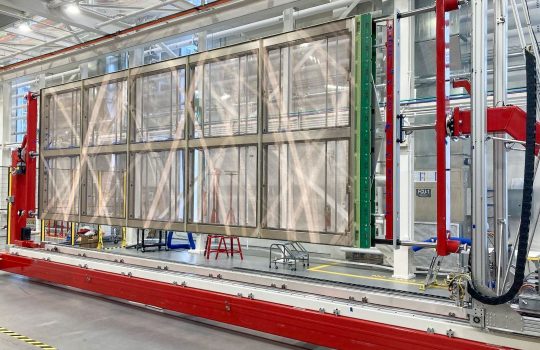An international project to build the largest physics experiment ever constructed in the United States took a major step forward as a new phase of work has begun at the project’s South Dakota site.
The U.S. Department of Energy’s Fermi National Accelerator Laboratory has finalized an agreement with construction firm Kiewit-Alberici Joint Venture (KAJV) to start pre-excavation work for the Long-Baseline Neutrino Facility (LBNF), which will house the enormous particle detectors for the Deep Underground Neutrino Experiment (DUNE). The South Dakota portion of the facility will be built a mile beneath the surface at the Sanford Underground Research Facility in Lead, South Dakota.
The contract with KAJV covers the next two years and includes everything that will be needed to support the next phase of work — the fast, safe and continuous removal of approximately 800,000 tons of rock to create the large caverns that will house the massive DUNE detector modules.
“After years of design and planning, it’s gratifying to put boots on the ground and begin this pre-excavation work,” said Chris Mossey, Fermilab’s deputy director for the Long-Baseline Neutrino Facility. “Getting to this point has been the result of a lot of work from the entire LBNF/DUNE team and our partners at KAJV, Arup, Sanford Lab and DOE, and we’re all ready for this next phase of the project to begin.”

In the international Deep Underground Neutrino Experiment, hosted by Fermilab, a beam of neutrinos will be sent from Fermilab outside Chicago straight through Earth’s mantle to Sanford Lab in Lead, South Dakota. Fermilab recently finalized an agreement with construction firm Kiewit-Alberici Joint Venture to start pre-excavation work for the Long-Baseline Neutrino Facility, which will house the detectors.
Included in the work is restoring and refurbishing rock-crushing equipment once used for the gold mine where Sanford Lab now resides and outfitting one of the mine shafts to carry loads of crushed rock. Much of the early pre-excavation work will take place underground at Sanford Lab or inside existing enclosures on site.
“Complicated tunneling, excavation and underground construction is what we do every day, but performing this work in support of a groundbreaking, international science experiment is a once-in-a-lifetime opportunity,” said Scott Lundgren, spokesperson for Kiewit/Alberici Joint Venture. “We are proud to be a part of this historic project and look forward to helping to make the vision for the LBNF become a reality.”
Fermilab and Sanford Lab will host an informational meeting in Lead, South Dakota, for local residents on Jan. 16, 2019, to answer questions about the construction of the project. The meeting will take place at 7 p.m. in the Education and Outreach Building at Sanford Lab. For more information, visit the event page.
DUNE, hosted by Fermilab, will be the world’s most advanced experiment dedicated to studying the properties of mysterious subatomic particles called neutrinos. Scientists are seeking to understand the role neutrinos played in the formation of our universe, and the DUNE detectors will enable them to study a beam of particles generated by an upgraded accelerator complex at Fermilab. The DUNE collaboration includes more than 1,000 scientists from more than 30 countries around the world. A large prototype detector for the experiment, constructed at the European research center CERN, successfully began recording particle tracks in September of this year.
For more information on LBNF/DUNE, see http://www.fnal.gov/dune.



